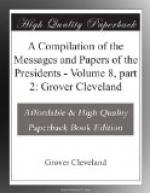Second. That the General Government is not competent to negotiate, unless, perhaps, on grounds of imperious public necessity, a conventional line involving a cession of territory to which the State of Maine is entitled, or the exchange thereof for other territory not included within the limits of that State according to the true construction of the treaty, without the consent of the State.
In these views of his predecessors in office the President fully concurs, and it is his design to continue to act upon them.
The attention of the Federal Government has, of course, in the first instance been directed to efforts to settle the treaty line. A historical outline of the measures which have been successively taken by it to that end may be useful to the government of Maine in coming to a conclusion on the proposition now submitted. It will, however, be unnecessary here to do more than advert to the cardinal features of this protracted negotiation.
The treaty of peace between the United States of America and His Britannic Majesty, concluded at Paris in September, 1783, defines the boundaries of the said States, and the following words, taken from the second article of that instrument, are intended to designate a part of the boundary between those States and the British North American Provinces, viz: “From the northwest angle of Nova Scotia, viz, that angle which is formed by a line drawn due north from the source of the St. Croix River to the highlands; along the said highlands which divide those rivers that empty themselves into the river St. Lawrence from those which fall into the Atlantic Ocean to the northwesternmost head of Connecticut River;” ... “east by a line to be drawn along the middle of the river St. Croix from its mouth in the Bay of Fundy to its source, and from its source directly north to the aforesaid highlands which divide the rivers that fall into the Atlantic Ocean from those which fall into the river St. Lawrence.” An immediate execution of some of the provisions of this treaty was, however, delayed by circumstances on which it is now unnecessary to dwell, and in November, 1794, a second treaty was concluded between the two powers. In the meantime, doubts having arisen as to what river was truly intended under the name of the St. Croix mentioned in the treaty of peace and forming a part of the boundary therein described, this question was referred by virtue of the fifth article of the new treaty to the decision of a commission appointed in the manner therein prescribed, both parties agreeing to consider such decision final and conclusive. The commissioners appointed in pursuance of the fifth article of the treaty of 1794 decided by their declaration of October 25, 1798, that the northern branch (Cheputnaticook) of a river called Scoodiac was the true river St. Croix intended by the treaty of peace.




